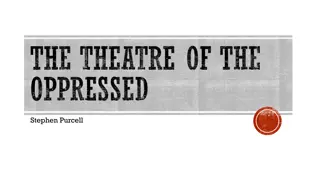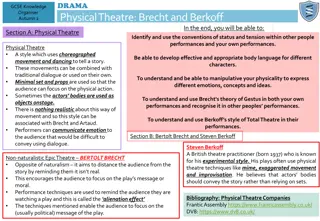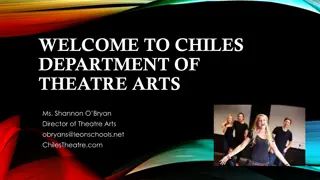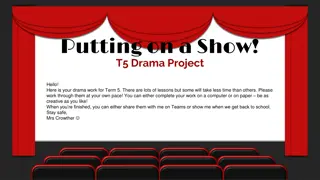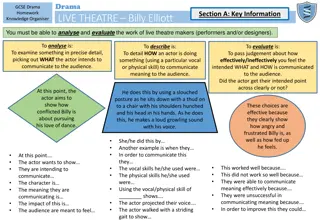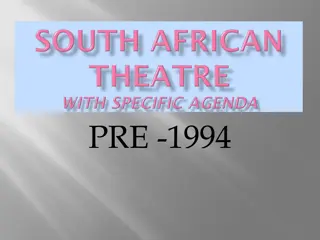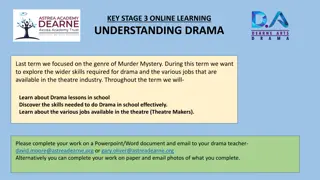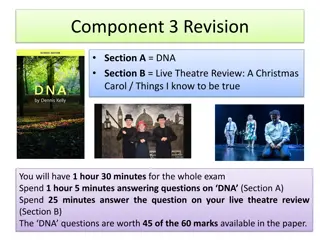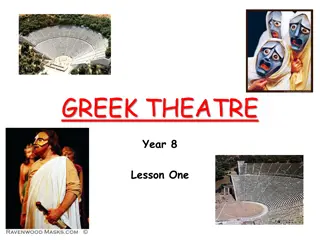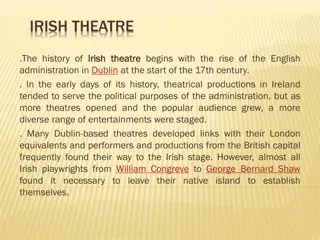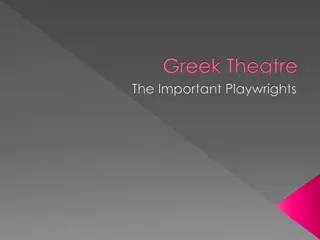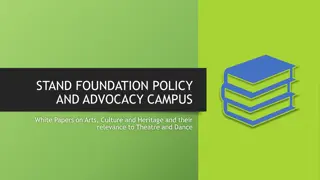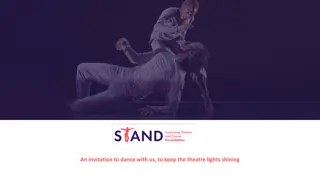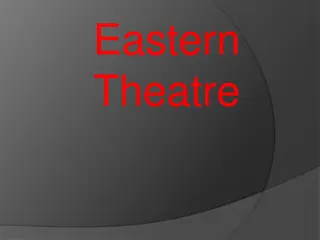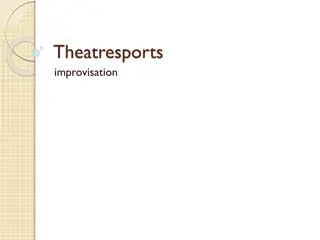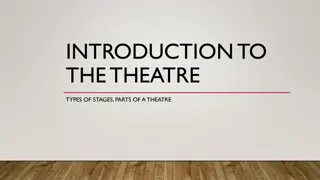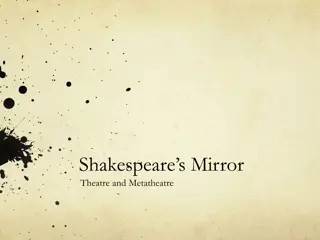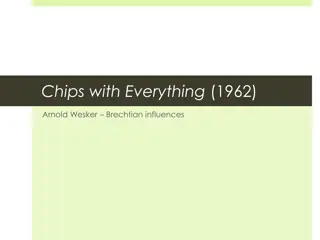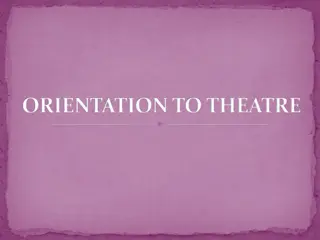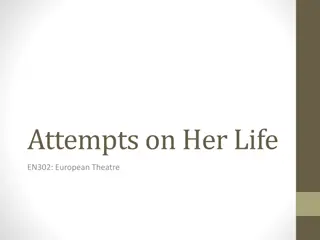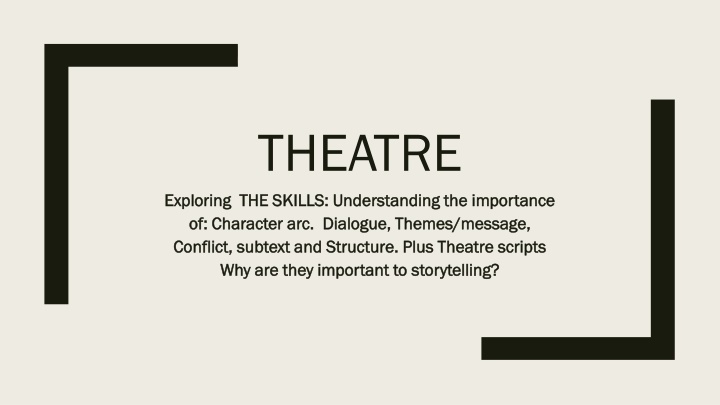
Creating Believable Characters Through Theatre Skills
Explore the importance of character development, dialogue, conflict, subtext, and structure in storytelling through theatre skills. Discover how these elements drive plots, convey messages, and engage audiences. Uncover the art of writing for the stage and the nuances of crafting compelling characters. Delve into the power of dialogue to reveal character depth and move stories forward, as well as the significance of subtext in conveying unspoken themes. Enhance your understanding of storytelling through theatre and unleash your creative potential.
Download Presentation

Please find below an Image/Link to download the presentation.
The content on the website is provided AS IS for your information and personal use only. It may not be sold, licensed, or shared on other websites without obtaining consent from the author. If you encounter any issues during the download, it is possible that the publisher has removed the file from their server.
You are allowed to download the files provided on this website for personal or commercial use, subject to the condition that they are used lawfully. All files are the property of their respective owners.
The content on the website is provided AS IS for your information and personal use only. It may not be sold, licensed, or shared on other websites without obtaining consent from the author.
E N D
Presentation Transcript
THEATRE Exploring THE SKILLS: Understanding the importance Exploring THE SKILLS: Understanding the importance of: Character arc. Dialogue, Themes/message, of: Character arc. Dialogue, Themes/message, Conflict, subtext and Structure. Plus Theatre scripts Conflict, subtext and Structure. Plus Theatre scripts Why are they important to storytelling? Why are they important to storytelling?
Aims and objectives Identify and explore how we create believable characters Explore and recognise the importance of character s need to drive action and plot Explore and understand how we can use dialogue as a tool for creating believable characters Explore and understand how we can use dialogue as a tool of show and not telling Explore the characteristics and rules of writing for theatre Identify the transferable crafting skills in theatre Identify resources for researching character and dialogue. Internal and external conflicts: what are they and why do we need to understand them?
Students to find answers too: Why do we tell stories? What is a story? What is the purpose of a story? How do we tell stories? What are the possibilities of a story? What kind of stories would you like to tell and how would you like to tell them? Describe the relationship between the author and the reader What does the reader/viewer expect from stories? Why do we like stories?
Aims and objectives How does the dialogue help us understand the characters? How does the dialogue help move the story on? Is there information left unspoken, not spoken about, or underlying theme to the writing/a message which is not stated directly but can be inferred i.e. subtext? Could you show more than tell through the dialogue e.g. a person s deeper feelings towards another?
Writing For Theatre. SEE Handout. 1. A story Playwriting is storytelling. Audience want to know What happens next. If by the end of page two the readers aren t asking what happens next then it is probably a failure. 2. Say Something Most plays have a message Super-objective social, emotional or political messages.
Methodology - How To Write 1. Structure Development of character: make sure they say and do things that tell audiences about them , their lives, personalities, values etc Development of Situation plan the revelation of the plot. What happens and the order it happens in. Crisis where everything comes to a head. Denouement everything gets explained The meat of the play: always ask: have I just given more information about the characters or have I advanced the plot?
Characters and dialogue How To Create Characters How To Create Characters https://www.youtube.com/watch?v=J9ucWkyTrVM How To Write Dialogue How To Write Dialogue https://www.youtube.com/watch?v=NnLRV-ru95Y
Voices Every character should have their own voice. HOW characters say things WHAT they say What they DON T SAY (subtext)
WHAT MAKES GOOD DIALOGUE? WHAT MAKES GOOD DIALOGUE? Each character s speech prompts questions/issues in the other s mind, directly triggering a response, or perhaps causing the next speaker to change tack. Each speech connects with the previous one, unless of course the speaker deliberately deviates from the established line of argument. Perhaps a speech challenges or contradicts a previous speech. Perhaps the characters contributions to the dialogue reveal conflicting motives or objectives. It reveals some new aspect of at least one of the characters involved, and ideally all of them. Perhaps it marks a significant development in the plot. Perhaps it resolves an outstanding issue and/or gives rise to a further issue to be resolved. It involves well timed interaction between the characters. It exposes aspects of character that might not be apparent from descriptive text.
Scene Changes Theatre audiences expect to be engaged in something and not to have short-attention-span episodes paraded before them scenes are not like film, we can t keep cutting from scene to scene unless Use lighting to change location
WRITE EVERYTHING Remember everything you want the audience or the actors to know must be written down. If the audience need to understand something it must be spoken by the actors, either one character to another or directly to an audience.
Independent study Find scripts to read looking at voice and dialogue especially. Alan Bennet John Osborne Arthur Miller David Mammet David Hare Martin McDonagh Katori Hall Nell Leyshon The VLE http://vle.cant-col.ac.uk/course/view.php?id=2410 https://www.digitaltheatreplus.com/
Conflict Internal and External Learning activities: Learning activities: name inner and outer conflicts students to write them in notebooks.
the three act structure 1. character need 2. need meets obstacles (internal or external) complications, 3. need satisfied or denied beginning = new mystery middle = needs intensified end = climax: face more complications before resolution
NEED Action = NEED = act on the need What is your characters need? What is the worst thing that could happen to them? What is the best thing that could happen to them? Result: HOW DOES IT CHANGE THEM!!? What is different afterwards?
external and internal conflict All story needs conflict, but the conflict doesn t always have to be world-ending, between two armies or even between two people. Stories can have both external and internal conflict or some combination of the two, and both are effective ways to build suspense and keep the reader turning pages. Conflict may consist of characters against others, characters against natural forces or characters against things within themselves such as their own emotions or impulses. The first two are external conflicts or conflicts that originate from outside the character while the latter internal conflict comes from inside the character. Conflict against others could be a character against another or against a group, an entire society, supernatural beings or any other sentient entities. A character might also struggle against nature as in the case of a storm or a fight to survive while lost in the woods. Internal conflict might include a character struggling with unpleasant habits or the psychological effects of past trauma
Conflicts: Conflicts: A struggle between opposing forces that sets the action in motion. An external conflict external conflict pits a character against something or someone outside himself or herself another character or characters or something in nature or society. (Also: Wider [other] conflicts: God, world issues, status quo i.e. outer an inner combined.) Braving the Elements: Person Vs. Nature Braving the Elements: Person Vs. Nature Person vs. nature finds the story's characters in a struggle against their external environment. Outer conflict Outer conflict - other person in scene (antagonist) - i.e. protagonist wants what the character wants. Someone stands in their way of achieving NEED Only One Can Win: Person Vs. Person Only One Can Win: Person Vs. Person Person vs. person is the classic showdown between the protagonist, the main character of the story, and the antagonist, the character who tries to bring about his downfall Sticking It to the Man: Person Vs. Society Sticking It to the Man: Person Vs. Society From Sophocles' "Antigone" to Ayn Rand's "Atlas Shrugged," literature is full of characters who stand up for their convictions by publicly taking a stand against external social forces. In person vs. society conflict, the protagonist is at odds with a particular ideology or group.
Conflicts: Conflicts: An internal conflict internal conflict happens when the opposing forces are two drives, impulses, or parts of a single character. Inner conflict Inner conflict - tussle in characters (protagonists) head: (Man/woman vs. Self) Battling Inner Demons: Person Vs. Self Battling Inner Demons: Person Vs. Self Direct outer conflict Direct outer conflict - both men love same girl Indirect Indirect - different needs but still conflict - 1 obsession - two conflicting needs, not the same thing still something getting in way of a characters need. Sister wants marriage - other sister wants to know how to deal with their father. Neither helping the other to overcome conflict and achieve needs
Conflict Something getting in way of a need. What is getting in the way of you character s need?
Discussion Discussion H How the internal and external needs can affect the characters and the story. Where needs are same same and different different and conflict arises Discuss characters and how they change throughout a narrative. Each student to discuss/write the inner and outer conflict of their main character.
Plenary: Plenary: Discuss how today s session has impacted on your writing and perhaps future writing development.
Subtext Subtext is a glorious medium. It adds depth there s the conversation that two characters are having, and there s the conversation underneath the conversation the two characters are having. The meaning behind the words.
Examples of Subtext Examples of Subtext Example 1 Example 1 She smiled when she heard someone else had won, but knowing what she was thinking, the smile was a fa ade which covered her true disappointment at having lost the election. The subtext in the situation is the reality that what is below the surface disappointment does not match the surface happiness and congratulations. Example 2 Example 2 A student goes to turn in his paper. After looking through two pages, his teacher asks, Are you sure you want to turn this in? The subtext of this question is the intended clue to the student that the paper is not ready yet to be turned in and he should edit through it again. Example 3 Example 3 This mint is really delicious. It s got a very unique flavour. Do you want one? The enthusiasm expressed by this person is an example of subtext. As beneath this message is the clue that someone else has bad breath and should take the mint.
Subtext RAY: Here we go, some nice peanut butter sandwiches. Rachel looks at him spreading the sandwiches, obviously masking frustration. RACHEL: I m allergic to peanut butter. Ray, surprised, continues to spread the butter. RAY: Since when? Beat. RACHEL: Birth
Subtext and motivation Exercise: Exercise: write a short piece that explores the need, but through what the character doesn't say - implies etc Scene between 2 characters: 1 wants the other to do/say something - admit to something - but never mention the thing. Use existing characters or create a new set What is it they want? Ask something without saying it?
Monologues by Alan Bennett from Talking Heads BBC They re all about action. Outside Dog Outside Dog : https://www.youtube.com/watch?v=XGZMe5DsnRU Miss Fozzard Finds Her Feet Miss Fozzard Finds Her Feet: https://www.youtube.com/watch?v=_J0XtWtloWE Write a short monologue: In theatre, a monologue speech presented by a single character, most often to express their mental thoughts aloud, though sometimes also to directly address another character or the audience. monologue is a
BennettsA Woman of No Importance. It stars Patricia Routledge as a gossipy spinster who thinks she s the centre of the office universe in denial of how illness is unexpectedly but swiftly taking her towards death. Rather than a morose Eleanor Rigby tale, it was a perfect example of that gap between what is said and what the audience can see. The gaps between scenes from doctors waiting room, to hospital bed, to empty bed, were, said Bennett, an ancient tradition of the monologue. Greek tragedy for example, in which characters are describing an event that s happened. They re all about action. He felt there was an assumption among some people that his monologues are static and without event. Inspiration came partly from the aunts of his Yorkshire childhood. He identified individual Talking Heads as being based on specific aunts; notably the one who recounted long rambling stories in the most frustrating way.
Scriptwriting At the end of the session take time to answer these questions. Once you have answered use the questions to edit, reflect and develop the script further. How does the dialogue help us understand the characters? How does the dialogue help move the story on? Is there information left unspoken, not spoken about, or underlying theme to the writing/a message which is not stated directly but can be inferred i.e. subtext? Could you show more than tell through the dialogue e.g. a person s deeper feelings towards another?
write a short play Pick two characters; choose a setting and an object. The two characters need the object or the object plays a part in the conflict between the two characters. Does your script explore a specific theme? Is there conflict in the script? Is the dialogue consistent with character? Does the dialogue help us understand the characters (what they say and what they do not say)?
Writing Exercise: A commission or theme from a competition Write a short play between 3 to 5 minutes on the theme of (longer if you wish up to 10 pages: The writing is on the wall. Use the Slides above Slides above to edit and reflect on the writing

